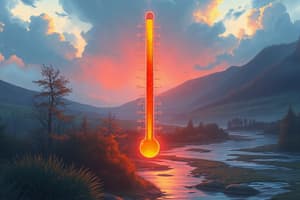Podcast
Questions and Answers
Which of the following is the MOST accurate description of the difference between weather and climate?
Which of the following is the MOST accurate description of the difference between weather and climate?
- Weather only occurs in the troposphere, while climate affects all layers of the atmosphere.
- Weather is predictable, while climate is random and unpredictable.
- Weather includes temperature only, while climate includes temperature, humidity, and precipitation.
- Weather is the atmospheric condition on a given day, while climate is the average weather pattern over many years. (correct)
A weather balloon (radiosonde) is released into the atmosphere. Which of the following combinations of weather elements would it MOST likely measure?
A weather balloon (radiosonde) is released into the atmosphere. Which of the following combinations of weather elements would it MOST likely measure?
- Temperature, humidity, pressure, and wind speed at various altitudes. (correct)
- Air quality index, carbon monoxide levels, and ozone concentration.
- Cloud type, visibility, and surface temperature.
- Precipitation, solar radiation, and ground temperature.
Which of the following statements BEST describes the relationship between air pressure and altitude in the atmosphere?
Which of the following statements BEST describes the relationship between air pressure and altitude in the atmosphere?
- Air pressure decreases exponentially with increasing altitude. (correct)
- Air pressure increases linearly with increasing altitude.
- Air pressure remains constant regardless of altitude.
- Air pressure decreases linearly with increasing altitude.
Isobars on a weather map connect points of equal atmospheric pressure. If you observe closely spaced isobars on a weather map, what weather condition is MOST likely occurring?
Isobars on a weather map connect points of equal atmospheric pressure. If you observe closely spaced isobars on a weather map, what weather condition is MOST likely occurring?
You observe cirrus clouds in the sky. Based on your knowledge of cloud types, at what altitude range are these clouds MOST likely located?
You observe cirrus clouds in the sky. Based on your knowledge of cloud types, at what altitude range are these clouds MOST likely located?
Which gas is the MOST abundant in dry air?
Which gas is the MOST abundant in dry air?
What is the function of a wind vane?
What is the function of a wind vane?
Which of the following BEST describes the role of the ozone layer in the stratosphere?
Which of the following BEST describes the role of the ozone layer in the stratosphere?
Which of the following weather elements is measured using a barometer?
Which of the following weather elements is measured using a barometer?
Which of the following factors has the MOST significant impact on local weather conditions?
Which of the following factors has the MOST significant impact on local weather conditions?
What is indicated by 'H' and 'L' on a synoptic weather chart?
What is indicated by 'H' and 'L' on a synoptic weather chart?
During a hot summer day, you hear a weather forecast mentioning a cold front approaching your area. What changes in weather conditions can you MOST likely expect?
During a hot summer day, you hear a weather forecast mentioning a cold front approaching your area. What changes in weather conditions can you MOST likely expect?
Which type of precipitation is measured using a rain gauge?
Which type of precipitation is measured using a rain gauge?
According to the weather forecast, the relative humidity is 95%. What does this indicate about the air?
According to the weather forecast, the relative humidity is 95%. What does this indicate about the air?
An anemometer is used to measure which weather element?
An anemometer is used to measure which weather element?
Flashcards
Weather
Weather
The condition of the atmosphere at a specific place and time.
Climate
Climate
Long-term average weather conditions in a region.
Humidity
Humidity
Amount of water vapor in the air.
Precipitation
Precipitation
Signup and view all the flashcards
Wind
Wind
Signup and view all the flashcards
Atmospheric Pressure
Atmospheric Pressure
Signup and view all the flashcards
Cloud Cover
Cloud Cover
Signup and view all the flashcards
Dry Air Composition
Dry Air Composition
Signup and view all the flashcards
Troposphere
Troposphere
Signup and view all the flashcards
Solar Radiation
Solar Radiation
Signup and view all the flashcards
Air Mass
Air Mass
Signup and view all the flashcards
Front
Front
Signup and view all the flashcards
Low-Pressure System
Low-Pressure System
Signup and view all the flashcards
Isobars
Isobars
Signup and view all the flashcards
Cloud Types
Cloud Types
Signup and view all the flashcards
Study Notes
- Weather is the condition of the atmosphere at a specific time and place.
- Weather is described by temperature, humidity, precipitation, cloudiness, visibility, and wind.
- Climate is the long-term average of weather conditions in a region.
Weather Elements and Measurement
- Temperature is measured using thermometers (mercury, digital) in Celsius (°C) or Fahrenheit (°F).
- Maximum and minimum thermometers record the highest/lowest temperatures over a period.
- Humidity refers to the amount of water vapor in the air.
- Relative Humidity (RH) is the ratio of actual to maximum possible water vapor at a given temperature.
- Humidity is measured using hygrometers (hair, electronic).
- Precipitation is any form of water falling from the atmosphere (rain, snow, sleet, hail).
- Rainfall is measured in millimeters or inches using rain gauges.
- Snowfall is measured using snow gauges (converted to water equivalent).
- Wind is the movement of air horizontally.
- Wind speed is measured using anemometers in kilometers per hour, miles per hour, or knots.
- Wind direction is measured using wind vanes, indicating from where the wind blows.
- Atmospheric Pressure is the force exerted by the weight of air above a point.
- Atmospheric pressure is measured using barometers (mercury, aneroid) in hectopascals (hPa) or millibars (mb).
- Cloud Cover is the fraction of the sky obscured by clouds.
- Cloud cover is measured visually in okta (eighths) or with automated sensors.
- Visibility is the distance at which an object can be clearly seen.
- Visibility can be measured visually or using transmissometers (in meters or miles).
Atmospheric Composition
- Dry air is composed mainly of Nitrogen (N2) at ~78%.
- Dry air is composed mainly of Oxygen (O2) at ~21%.
- Dry air is composed mainly of Argon (Ar) at ~0.9%.
- Trace gases include neon, helium, methane, krypton, hydrogen, and ozone.
- Water Vapor (H2O) varies significantly (0-4%) depending on location and conditions.
- Aerosols are tiny solid or liquid particles suspended in the air (e.g., dust, sea salt, pollutants).
Atmospheric Layers
- Troposphere is the lowest layer where weather occurs; temperature decreases with altitude.
- Stratosphere contains the ozone layer; temperature increases with altitude.
- Mesosphere's temperature decreases with altitude.
- Thermosphere's temperature increases with altitude.
- Exosphere is the outermost layer, gradually merges into space.
Weather Processes
- Solar Radiation: The primary energy source for the Earth's weather systems.
- Differential heating of the Earth's surface creates temperature gradients.
- Air Masses: Large bodies of air with relatively uniform temperature and humidity characteristics.
- Fronts: Boundaries between air masses (cold, warm, stationary, occluded).
- Low-Pressure Systems (Cyclones): Associated with rising air, cloud formation, and precipitation.
- High-Pressure Systems (Anticyclones): Associated with sinking air, clear skies, and stable conditions.
Weather Forecasting
- Surface observations include Data from weather stations, ships, and buoys.
- Upper-air observations include Data from weather balloons (radiosondes).
- Remote sensing includes Weather satellites and radar provide images and data.
- Numerical Weather Prediction (NWP): Computer models that simulate the atmosphere.
- Forecast maps: Visualization of weather elements (pressure, temperature, precipitation).
Measurement Instruments
- Thermometer measures air temperature; common types include liquid-in-glass (mercury or alcohol), digital, and bimetallic strip thermometers.
- Barometer measures atmospheric pressure; mercury barometers are traditional, while aneroid barometers are more portable.
- Hygrometer measures humidity; hair hygrometers use human hair, while electronic hygrometers use capacitive sensors.
- Anemometer measures wind speed; cup anemometers use rotating cups, while sonic anemometers use sound waves.
- Wind Vane indicates wind direction; points in the direction from which the wind is blowing.
- Rain Gauge collects and measures rainfall; standard rain gauges are manual, while tipping bucket rain gauges are automated.
- Weather Balloon (Radiosonde) carries instruments aloft to measure temperature, humidity, pressure, and wind at various altitudes.
- Weather Radar detects precipitation intensity and movement; Doppler radar can also measure wind speed.
- Weather Satellite provides images of clouds, temperature profiles, and other weather data; geostationary and polar-orbiting satellites are common.
Basics of Synoptic Weather Charts
- Isobars are lines connecting points of equal atmospheric pressure.
- Isotherms are lines connecting points of equal temperature.
- Frontal Symbols indicate the type and location of fronts (cold, warm, stationary, occluded).
- High and Low Pressure Centers are marked with "H" and "L" respectively.
- Wind Barbs indicate wind direction and speed.
- Cloud Cover Symbols show the amount and type of cloud cover.
Cloud Types
- High Clouds: Cirrus (Ci), Cirrocumulus (Cc), Cirrostratus (Cs).
- Mid-Level Clouds: Altocumulus (Ac), Altostratus (As).
- Low Clouds: Stratus (St), Stratocumulus (Sc), Nimbostratus (Ns).
- Vertical Clouds: Cumulus (Cu), Cumulonimbus (Cb).
Factors Affecting Weather
- Latitude affects the angle of incidence of solar radiation.
- Generally, temperature decreases with altitude.
- Proximity to Water moderates temperature and increases humidity.
- Ocean Currents transport heat around the globe.
- Topography/Mountains can cause orographic lift and rain shadows.
Air Pollution
- Sources: Industrial emissions, vehicle exhaust, agriculture, natural sources (e.g., volcanic eruptions, dust storms).
- Pollutants: Particulate matter (PM), ozone (O3), sulfur dioxide (SO2), nitrogen oxides (NOx), carbon monoxide (CO).
- Effects: Respiratory problems, cardiovascular diseases, environmental damage.
- Air Quality Index (AQI) measures air quality based on pollutant concentrations.
Weather Hazards
- Thunderstorms bring heavy rain, lightning, strong winds, hail, and tornadoes.
- Hurricanes (Typhoons, Cyclones) are intense tropical cyclones with strong winds and heavy rain.
- Tornadoes: Violent rotating columns of air extending from a thunderstorm to the ground.
- Floods: Overflow of water in normally dry areas.
- Droughts: Prolonged periods of abnormally low precipitation.
- Heat Waves: Prolonged periods of abnormally high temperatures.
- Blizzards: Severe snowstorms with strong winds and low visibility.
- Ice Storms: Freezing rain that coats surfaces with ice.
Studying That Suits You
Use AI to generate personalized quizzes and flashcards to suit your learning preferences.




